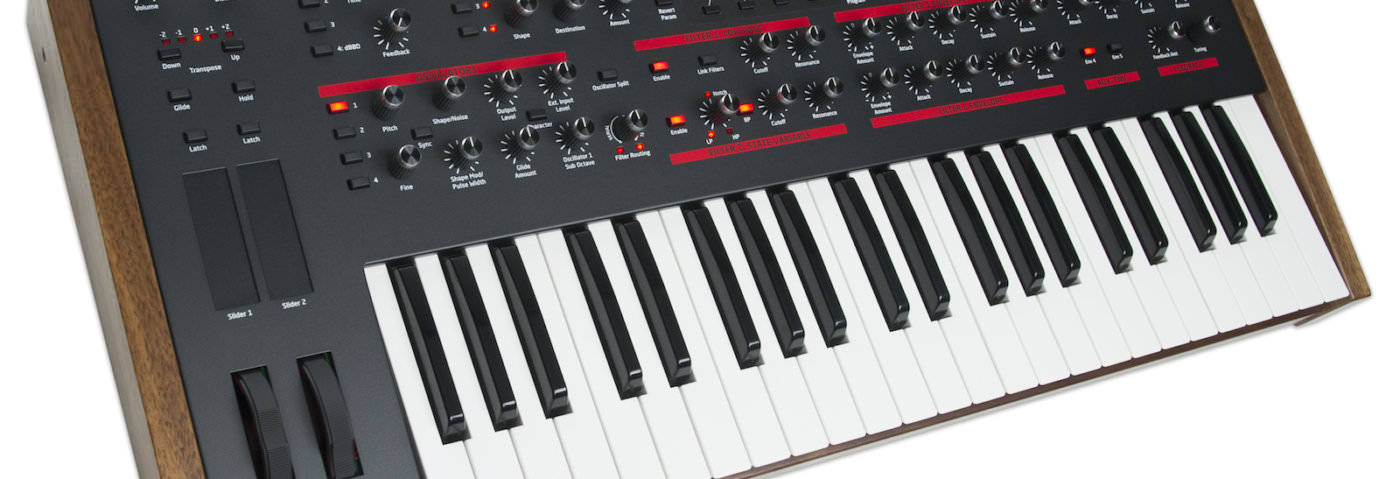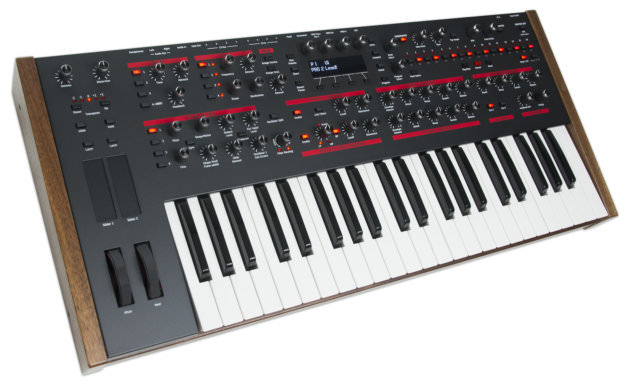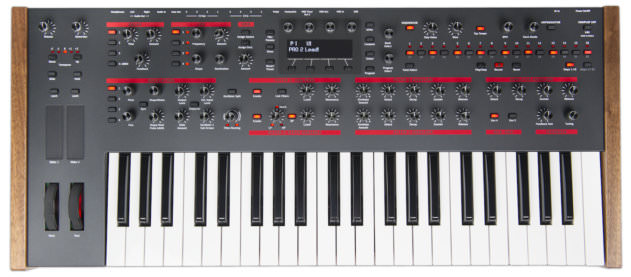Dave Smith Instruments introduces new flagship monophonic synth. We want one. You probably do too.
“As synth geeks, we asked ourselves what our ultimate mono synth would be. Then we built it.” It’s the kind of marketing bluster which we hear day in, day out – and the kind of pronouncement you normally take with a pinch of salt, if not dismissing it entirely. But when it comes from the man responsible for some of the best synths ever made, it’s impossible not to take notice. DSI’s newly announced Pro-2 looks seriously impressive.
Dave Smith, to his credit, has always been more interested in innovation than looking to the past. “Right now there’s a trend of reissuing classic synths from the past,” he explains. “People have been asking for a reissue of the old Sequential Pro-One for quite a while. But as a synth designer, I’m happiest creating new instruments—synths that with every iteration put more power and better sounds into the hands of musicians. The Pro 2 is light years beyond the Pro-One in every way. It’s the most powerful mono synth I’ve ever made. You’ve got to keep moving forward.”
The Pro-2 is based on the Prophet 12 synth architecture but makes a number of changes. That means you’ll get four oscillators and a sub-oscillator, dual filters with some clever routing options, a step sequencer, built-in delay, an arpeggiator, four LFOs, character controls and two pressure-sensitive touch sliders. We’ve seen a trend in recent years for affordable monosynths – usually with relatively limited features sets as a result – but the Pro-2 is resolutely aimed at the other end of the market: this is a premium, money-no-object, flagship synth.
Watch Dave Smith’s intro video above or scroll down for the full spec and hi-res photos of this flagship synth in all its glory.
The Pro-2 will go on sale in late July, priced at $1,999. Expect that to translate to somewhere in the region of £1,400/€1,600 in Europe.
Specifications
Oscillators
- Four DSP-based oscillators plus one sine wave sub oscillator
- Four classic wave shapes (saw, square, triangle, sine) per oscillator
- Twelve selectable complex shapes per oscillator
- 13 Superwaves
- Three noise types per oscillator: white, pink, violet
- Shape modulation/pulse width/superwave detune amount
- Oscillator cross modulation: frequency modulation (FM) and amplitude modulation (AM)
- Hard sync, individual Glide, Oscillator Slop
Paraphonic Playability
- True 4-voice paraphonic mode with individually-gated envelopes per oscillator
Character Effects
- Five high-quality digital effects. Thicken the signal and add harmonics or completely destroy the signal pre-filter.
- Girth and Air are high and low shelf equalizers with harmonic excitement. Useful for thickening and/or adding air to the signal.
- Hack and Decimate are sample and bit rate reduction algorithms which can add subtle grit or completely trash the signal. It’s harsh yet musical.
- Drive is a soft saturator for adding soft distortion and harmonic content to the signal
Filters
- Dual analog filters operate in serial or parallel
- Filter 1 is a 4-pole resonant analog low-pass filter inspired by the original Prophet-5 filter.
- Filter 2 is a 2-pole resonant analog state-variable filter inspired by the Oberheim SEM filter and can be continuously varied between low-pass, notch, and high-pass operation, with an optional band-pass mode.
- Oscillator Split allows oscillators 1 & 2 to be sent to Filter 1 and oscillators 3 & 4 to Filter 2.
Feedback and Delay
- Tuned Feedback
- Three-tap syncable delay with feedback and amount controls, pan, and high-pass and low-pass filtering, all per delay. A separate fourth delay is a digital bucket-brigade delay (BBD) for analog-style effects.
Envelopes
- Five Delay + ADSR envelopes (Filter 1, Filter 2, VCA , and two Auxiliary envelopes)
- Auxiliary envelopes 4 and 5 freely assignable to multiple modulation destinations
- All envelopes can repeat/loop
LFOs
- Four syncable LFOs with phase offset and slew per LFO
Modulation
- 16 x 2 modulation matrix with over 50 mod sources and over 140 mod destinations
- Parameters that can be sent to CV outputs include oscillators, LFOs, envelopes, sequencer tracks and any other source within the modulation matrix. Runs up to audio rates.
- Gate Out for triggering external CV-compatible devices; any CV in can be used as a gate input.
Control Voltage Ins & Outs and Gate Out
- Four 1-volt-per-octave control voltage inputs and outputs for interfacing with modular synths and other CV-compatible devices
- Modulation assignment buttons enable quick and easy modulation routing.
- Mod Matrix runs up to audio rates.
Sequencer
- Advanced step sequencer provides up to 32 steps per sequence and up to 16 tracks.
- Supports real-time input, rests, and variable-length sequences
- Syncs to MIDI clock and external audio and CV input
- Sequences can control not only oscillator pitch but any parameter in the modulation matrix.
Arpeggiator
- Sophisticated arpeggiator with up, down, up+down, random, assign modes
- Supports real-time input, rests, and variable-length sequences
- Re-latching arpeggiation
Programmable Distortion
- Stereo analog distortion
Controls
- More than 50 knobs and 65 buttons enable deep and comprehensive editing with minimal menu diving.
- Backlit pitch and mod wheels are easily visible in low-light situations and have a smooth yet precise feel and response.
- Independently adjustable upper and lower pitch wheel range
- Two assignable position- and pressure-sensitive latchable touch sliders for enhanced interactivity and control
- Full-sized, three-and-a-half-octave, semi-weighted keyboard with velocity and aftertouch
Memory
- 396 user and 396 factory programs
- Playlist mode for generating easily accessible setlists of your favorite programs
I/O
- 1 MIDI In, 1 MIDI out, and 1 MIDI Thru/Out 2 port
- USB port for bidirectional MIDI communication
- 4 CV inputs (4 x 1/8″ jack)
- 4 CV outputs (4 x 1/8″ jack)
- 1 Gate Out (1/8″ jack))
- 1 Sustain/footswitch input
- 1 expression pedal input
- 1 external audio input (1/4″ phone jack)
- Main stereo output (2 x 1/4″ phone jack)
- Headphone out (stereo 1/4″ phone jack)
Power
- 1 universal IEC AC power inlet for internal power supply
- Operates worldwide on voltages between 100-240v, 50-60Hz, 30 watts maximum power consumption
Physical Specs
- Walnut end panels and trim
- Dimensions: approximately 29.2″ L x 12.8″ W x 4.15″ H (74.2 cm x 32.5 cm x 10.5 cm)
- Weight: 18.7 lbs (8.5 kg)





07.29 AM
1400€ for a synth I can’t even press 2 Keys at the Same time? I’ll stick with minibrute, Thanks tho.
09.07 AM
I see it quite different. This is a beautiful synth with lots of possibilities. 2k is not that much for this piece compared to what other companies offer. Look at the connectivity, the sequencer, filter types and modes, FX …
This one will be the first DSI I will for sure buy.
12.02 PM
2k$ is too much money… I hope they finish the Tempest OS (total midi implementation please)
12.10 PM
Seems like people just don’t understand the meaning of a high-end monosynth any more. This thing looks closer to a Voyager XL than a Minibrute. For the price of a Voyager XL you could buy a Pro 2 and have money left over for a Prophet 12. Still think it’s overpriced?
OK, stick to your cheap, plastic Minibrute. I’m already planning to sell my Mopho and Sh-101 to buy a Pro 2 (the sequencer with clock input can replace what I use the 101 for now, even if the sound is different).
01.16 PM
The digital oscillators don’t sell it to me.
Bass is not the strength of the Prophet 12 and its not just the filters at fault. Not sure why the Pro 2’s oscillators will be much different.
I also don’t know why people would sell real analogue for this synth, I don’t think it will be able to replace it, it will be different (someone Ive read planning to sell their M/P for this).
01.36 PM
J mon, I’d rather stick with my plastic monophonic that i absolutely adore and save for a analog polysinth. I was never into the hig end monophonic stuff, yeah, moogs a re beautiful, but cheaper options gets the work done as well. Polysinths are a different question, but i guess your opinion is the only one that counts, right?
10.59 AM
the price is definitely OK. if people cant afford it there are many other options. this is a real instrument with A LOT of options and creamy analog filters, step sequencer, arpeggiator, CV connections, endless modulation possiblities, etc.. it is not just meant to “get the job” done, you’d probably waste your money if you are looking for gear that is just doing that. this one here is made for doing much more…
02.54 PM
Based on that video, I think I would really enjoy this synth. I don’t care if it is analog, digital or a bit of both. – to my ears it sounds great.
In DSI tradition, I expect there will be a rack version soon. Without the sequencer and Keyboard, the price should be much better and I’ll definitely give it consideration. Hopefully they’ll keep the knobby interface but that might be wishful thinking.